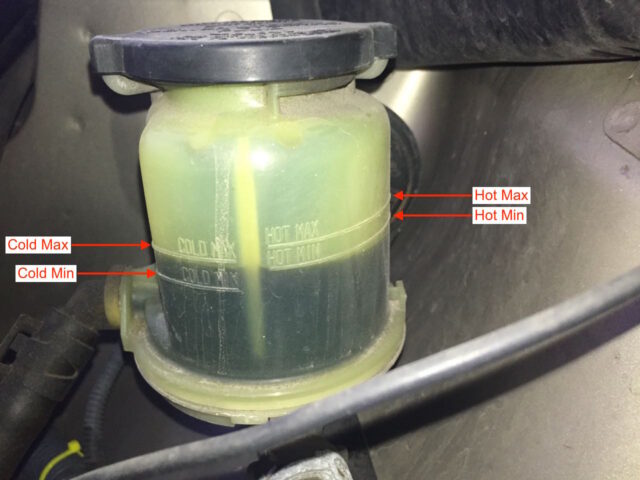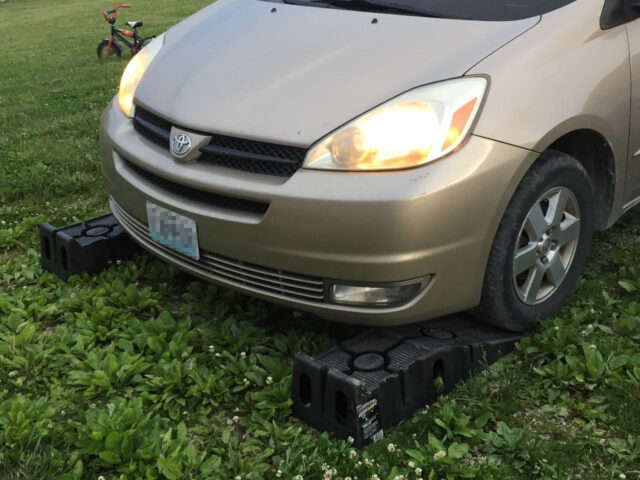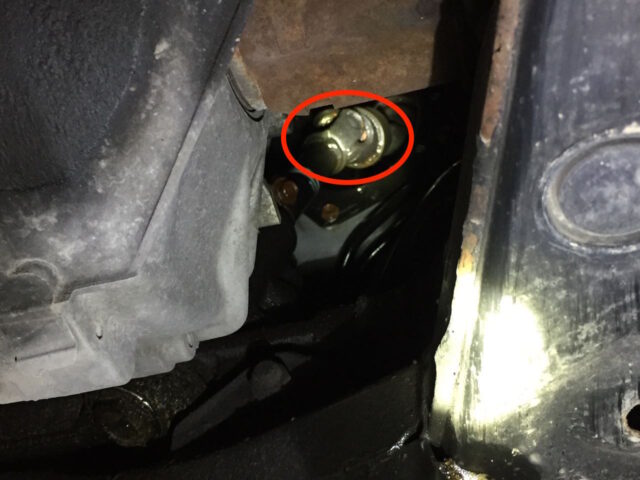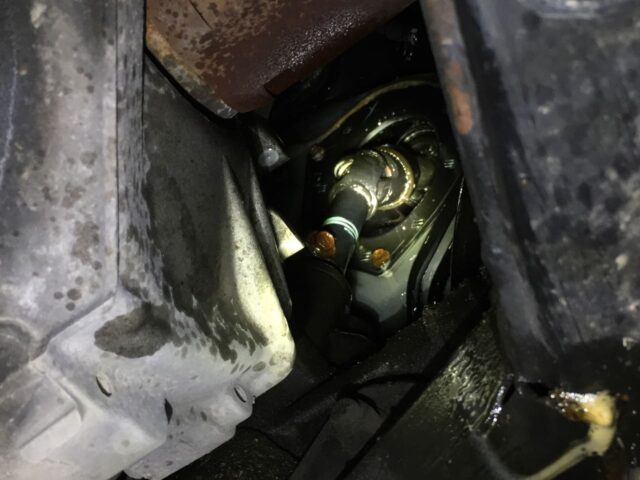I first noticed stiff steering when I was driving down the interstate, trying to make small adjustments in steering, and I felt resistance to turning the steering wheel. Steering should be smooth and easy but at certain points I found that there was resistance to turning the steering wheel–not good. I always could turn the wheel but it just wasn’t smooth and easy like it should be. After a couple drives the condition persisted and I decided to get to the bottom of it. What I learned was that this is an issue that you may be able to remedy with not that much effort. It turns out that the issue is that the u-joint on the steering link shaft, on the outside of the firewall, is exposed to water and salt and the u-joint gets stiff. This stiff steering knuckle is something you can fix it yourself. Read along so I show you how to fix Toyota Sienna stiff steering.
After performing this “patch” multiple times (since it only lasts for a month or two, I have now fixed the problem permanently, and you can too with my help. Please see my article: Toyota Sienna Steering Intermediate Shaft Replacement.
How to Fix Toyota Sienna Stiff Steering
Vehicle:
Tools:
Supplies:
Step 1: Check your power steering fluid level.
The first thing I did was verify that my power steering fluid was full. Park your van on level ground and then pop the hood. The location of the power steering fluid reservoir can be seen here:

The reservoir is made of translucent and the level indicator is built into the plastic container. There are two sets of lines, one for reading the level when the vehicle has been running and is hot and one for if the vehicle has been sitting and is cold.

My van’s power steering fluid was nearly full to the max so I figured the issue had to be something else. I also was not hearing the power steering pump “whine” when I turned the steering wheel. If your power steering fluid is full and are still experiencing stiff steering then read on…
Step 2: Drive your van up on ramps.
Having the van up in the air a bit makes this repair so much easier.
Step 2a: Place the ramps directly in line with the front wheels.

Step 2b: Look out your driver-side window to guide yourself as you drive up on the ramps.
One tip is that you should not turn your wheels as you are driving up the ramps because when you turn the wheels the ramps will turn with the wheels. You need to be lined up straight and then carefully drives straight up on the ramps.

Once the van is up on the ramps I put a piece of cardboard down to lay on:

Step 3: Locate the u-joint on the steering shaft u-joint.
A word of caution: You should wait for your van to cool off before crawling under your van. The Sienna’s exhaust system is near the area where we will be working and you could seriously burn yourself if not careful.
This u-joint is located on the shaft that leads from the steering wheel column, through the firewall, and down to the steering rack. I have highlighted the u-joint on the diagram below:

You cannot see this shaft from the top side of the van. You can take off the left wheel or you can look under the van–I chose the latter. Here is the path you must look through, to the inside of the beam, just behind the oil pan:


Shine a flashlight up in that hole to see the u-joint:

Close up you can see that this u-joint is immediately on the external side of the van’s firewall and that this is a rather sharp angle:

Step 4: Soak the u-joint with Liquid Wrench Penetrating Oil.
Install the straw on the spray nozzle and be careful not to get dripped on.

Soak the u-joint thoroughly.

Step 5: Remove the van from the ramps and turn the steering wheel.
Carefully back straight down off the ramps and then drive the van in a safe location where you can spend some time turning the steering wheel to allow the penetrating oil to soak into the u-joint. Be intentional to turn the steering wheel all the way to the right and left. When I did this I did not experience the hard steering at all anymore.
Step 5: Repeat Steps 2-5.
I doused my u-joint twice with penetrating oil, while I had the ramps out, to try to really get the oil down into the joint. I plan on repeating these steps in the future if we experience any sort of difficult steering on the van as this is a temporary repair.
Successful with this repair? Do you have a tip to add? Please leave a comment!
If this works for you, you have likely saved over $500 in repairs or at least put it off till the next owner!?! Please leave a comment if you were able to fix your van using this article and encourage others to do it themselves too. If you learned a shortcut or have any other relevant tip please share that as well in the comments. Please note: if you do not have any approved comments on this site then your comment must be personally approved by me before it will appear. I do this to keep my site 100% free of spam comments. I read them all and almost always review and respond to all comments within a day. I look forward to hearing from you.
Amazon Associate Disclosure: As an Amazon Associate I earn from qualifying purchases. This means if you click on an affiliate link and purchase the item, I will receive an affiliate commission. The price of the item is the same whether it is an affiliate link or not. Regardless, I only recommend products or services I believe will add value to Share Your Repair readers. By using the affiliate links, you are helping support Share Your Repair, and I genuinely appreciate your support.



This was a great solution to my sienna 2004. i applied WD- 40 to the lower U-joint and also guage all my tires adequately. my steering is now okay. many thanks for this tips.
This is only a temporary fix. I have written up how to actually fix the problem here: Toyota Sienna Steering Intermediate Shaft Replacement
Hello everyone, I wanted to update all of you who are following this article that I have permanently fixed my Sienna’s stiff steering and have written an article on it so you all can too: Toyota Sienna Steering Intermediate Shaft Replacement
I have done this a few times but recently the steering got real stiff in just a couple positions. I went ahead and changed the intermediate shaft out with an aftermarket part for about $140. I will not attempt to do the excellent tutorial that John does, but this is not too bad a job. I will say that I did not mark the position of the shaft and pinch bolts but before I buttoned up the interior I went for a couple quick drives to dial the wheel position in. I found on the old part from my 2004, one of the axis in the joint was worn out. I think Toyota made some improvements after 2006 or so? My van has the stability control and I quickly found that any changes to the wheel position will cause this system to misfire. A 2 second disconnect of the battery resets this or if you have access to the Toyota Tech-Stream that would be even better. The difference is night and day-the steering feels real tight and the rattle from the column is gone.
How is your fix holding up? My mechanic replaced my 2005 Sienna power steering rack and pinion over the weekend since it was seeping a little. I thought it would fix the stiff steering wheel during a turn issue. This morning when I left the house, I felt the steering wheel get stiff making a right turn. It was cold out this morning as well. I called my mechanic to let him know of the issue and he will look at it again. He mentioned it could be the power steering pump or switch. I will ask him to look at the steering shaft as well.
I’ve had to go back and lube up my u-joint at least twice since my initial repair write-up. The reason your repair didn’t fix the problem is because when they replace the rack and pinion, they don’t replace the part that is causing the stiff steering–the exterior u-joint of the steering intermediate Shaft Assembly. Your leak may have required the rack to be replaced but I believe the stiffness is this corroded u-joint, shown again below. I plan on replacing mine and writing up this repair this summer if I have time.

That makes sense. Would you recommend the Toyota OEM steering intermediate shaft or an aftermarket one would do the job? I’ve seen pricing anywhere from $95 up to around $210 for the one for AWD. I am not trying to spend too much money on my aging van. I would like something that won’t fail in a year or two. Thank you for the response John. I wonder if Bill’s repair is still holding up?
I plan on buying the Dorman Aftermarket Part off amazon.com. I haven’t heard anything back from Bill on any problems.
According to the Amazon.com listing, it is easy to install. Does this mean I need another wheel alignment? I just got one after the power steering rack and pinion was replaced.
The wheel alignment will not be necessary as the trueness of your wheels will be unaffected. The end of the shaft on that steering link looks like a fine-toothed gear on the end and the female part is mated/machined to match and you will want to make sure the part goes back together exactly like the old one or your steering wheel will be crooked and/or you can experience non-linear steering because the u-joints are not lined up. The Sienna’s computer also monitors steering for traction control and the system can go bonkers if the steering wheel is on crooked. Make sure to mark the parts before you disassemble them. I will share all the lessons I learn (and mistakes I make) on this once I do my repair 🙂 I believe that the difficulty in this repair will be getting the old part off since the connections will be full of corrosion and fine sand, etc. My one reader who shared his repair with me mentioned using an air chisel/hammer to get the shaft off. Back to lining up the shaft exactly like the old part–I found a couple videos which explains why this is critical:
More to come!!
The Doorman part is holding up great-no issues at all. Our stiff steering is no more. The rattle that has been in the column since we purchased at 60K miles is still gone. I do regret not doing this sooner. I assumed the job was harder than it was.
Good to hear Bill. It’s on my list to do that repair this summer and write it up for the site. Thanks for sharing your experience.
Thanks for the advice it fixed the problem in 10 mins.this u-joint should have a boot like a cv joint to permanently solve this problem. Toyota probably doesn’t want to spend the money on a permanent solution
That is correct and because this u-joint doesn’t spin (rapidly), there’s no reason it should wear out. I am now thinking about buying an aftermarket cv-joint boot that comes in 2 pieces and to put it on this u-joint and fill it with grease and see if that is a solution that will at least last until the seals on my steering rack wear out!?!? Thanks for sharing.
Great advice. I went in from the left after removing the left from wheel. WD-40 has a spray can with a flexible extension that makes it easy to get the product right on the joint. I spray it a couple times with WD-40, drove a bit and exercised the joint. I then lubed it up with silicone lube as that’s what I had on the shelf. It’s working great. Thanks.
Thanks for sharing Matt. I think I’m going to try your method next time (removing the left front wheel) but I’m going to put on a rubber glove and take some very thick grease and massage it into the u-joint by hand. I believe this will last longer since it will keep the moisture out and the grease will stay put. I’ve had to re-spray ours a couple times now since this issue initially crept up and I wrote the article. The steering gets stiff but once I spray the u-joint it is as smooth as silk again. I’ll update the post once I find out how that works.
Really impressed by your figuring this out, and especially appreciate your taking the time to diagram it out for an automotively challenged person like me. Thank you.
Thanks for taking the time to leave a comment. I cannot take credit for “figuring this out” because I searched the internet and read what was out there, but I did not find anyone giving good instructions as to how the average user might be able to do it too, and that’s where my site comes in 🙂 I’m glad you were able to solve your steering problem (at least temporarily).
Having the same problem with my 2005 Sienna. Going to give this a try for sure. I was thinking down the lines of not enough rack lash. But this seems more appropriate. Thanks for the post.
Tyler, thanks for your comment. I have had to lubricate my u-joint a couple times now but it does take care of it temporarily. I wish I had a lift where I could get the van up in the air enough that I could reach up to the u-joint and massage some thick grease into the joint.
Actually, no, but I wondered if the vibration might make them get loose, once the penetrating oil got into the threads.
Very clear presentation. Did any bolts get loose after applying the penetrating oil?
Thanks for the question Vin. I’ve only driven about 100 miles since I did the repair so the answer is no, so far. There are no bolts in the u-joint itself but there are other bolts in that area. I’m not worried about the bolts loosening themselves. Have you ever hear of spraying penetrating oil on a bolt and having it work its way out?
I had a very tight steering on Sienna 2004. Penetrating oil did miracle. It has been about 3 weeks after I used penetrating oil, and steering works like new.
Thanks for the info on this site.
I visited a few repair shops before I solution on this site.One repair shop wanted to change the steering oil pump, another one wanted to change rack and pinion and third one wanted to change both pump and rack&pinion.
Thanks for sharing, I’m glad you were able to get your steering loosened up. I must admit that after spraying down our u-joints and having it clear up the problem, we are experiencing it again already, 2 months later. I’m going to spray it down again though.